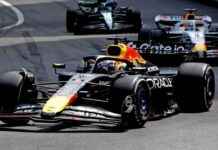It’s an impressive car, waiting in the visitors’ car park in front of the Opel plant in Rüsselsheim, waiting to be driven again: a steel-grey Manta GSi in an exclusive special version by the Opel specialist Irmscher, built in 1988, with a beautiful sunroof and double headlights , red racing seats and a rather conspicuous rear spoiler. The manufacturer took the vehicle, which was in almost immaculate condition, from its classic car depot and made it available for a drive. The Manta was built over a million times in the 1970s and 1980s, and it celebrated its 50th birthday three years ago.
He’s just experiencing a comeback, at least on the big screen: 32 years after the start of the comedy “Manta, Manta”, Til Schweiger is bringing a sequel to the cinemas. In it he plays the recalcitrant mechanic and former racing driver Bertie, who competes again in a vintage car race and takes his old sled out of the garage, a wide-bodied monster with a fabulously horrible multicolored paint finish in yellow, turquoise and purple.
To this day, the Manta is considered the preferred means of transport for rather simply knitted types with voluminous hairstyles, worn-out cowboy boots and well-tanned elbows, who are better avoided at folk festivals. He plays in a league with East Frisians, blondes, civil servants and hunters: they all have their own category of jokes. For a car guy, that’s a very rare achievement.
If you get behind the wheel of this car today, you are immediately reminded of how much the automobile has developed over the past 30 years. The few controllers, buttons and shift levers seem strangely delicate and fragile, there is no airbag, no cup holder, not even a cigarette lighter. Just a tape deck with auto reverse and a traffic button. It is also striking how narrow the cars were back then. When you roll down the window on the driver’s side, your elbow goes through the window almost by itself, as if that were the only position intended for it in the owner’s manual.
By the time the Manta cult hit its peak in the early ’90s, the car was actually a thing of the past. Production stopped in 1988, so the steel-gray coupé from the Opel depot is one of the last of its kind. From today’s perspective, it’s hard to understand why the box used to pass as a kind of sports car. With a mere 110 hp, the former king of the country road is now more at home on the right lane of the motorway than on the left – and even has to let a Dacia Duster pass it.
The four-cylinder engine produces a guttural hum, with the vibrations being transmitted throughout the car, including the driver’s forearms. After just a two-hour tour, you get the impression that you’ve done quite a bit. It’s an uplifting and oddly familiar feeling that transports you back to a time when 200 kilometers seemed incredibly far.
You would prefer not to give the car away at all, even if the heat builds up in the interior at outside temperatures of around 25 degrees and the steering wheel quickly gets so hot in direct sunlight that you can hardly touch it. No wonder Manta drivers were so fond of wearing gloves and opening the side windows when on the road.
However, a well-kept Manta in its original condition is rare to find these days. Most of the specimens were fitted by their owners with wide tyres, fitted with harness belts and draped with racing stripes, they were widened and lowered, even the dashboards were unscrewed and covered with colored foils to emphasize the car’s potency.
The inspiration came from rallying, where Opel was at the forefront at the time. However, the interventions and conversion work were not only about increasing performance, but also about signaling a kind of tribal affiliation and a constant willingness to test strength when the souped-up carts gurgled along the winding country roads of structurally weak regions and were unpopular with other road users made.
At the beginning of the 1990s, the negative image of the Opel Manta was cemented by two comedies, each of which attracted over a million viewers to the cinemas and could hardly be surpassed in terms of simplicity. In “Manta, Manta”, Til Schweiger drives the aforementioned wide-body monster in his first major role, constantly making a face as if he were about to start crying.
In the film’s funniest scene, he complains that one of his Manta buddies secretly graduated from high school (“And you’re going to college next, aren’t you?”). “Manta – the film” is not quite as clumsy and silly. In it, the teenager Manfred wishes for a Golf GTI for his 18th birthday, but gets an Opel Manta and is then left by his girlfriend. In both Manta films, the cars constantly pull away with squeaking and smoking tires, and there are several adventurous races and chases.
Originally, the Opel Manta was launched as an answer to the popular Ford Capri. The car was presented to the world public in autumn 1970 at Timmendorfer Strand. Longtime Opel designer George Gallion borrowed the name from the animal kingdom. “Animal names fit the zeitgeist back then,” he recalls in a press release on the model’s 50th anniversary. “In the US, the Ford Mustang and the Corvette Stingray were very successful. The Manta was just such a European-style pony car.”
Opel was targeting young fathers with a limited budget who needed a bit of space in their car but weren’t ready to give up their self-image as a daredevil yet. Even if the car itself was rather poorly motorized by the standards of the time, the strategy worked: The Manta A sold almost half a million units and was therefore a great success for the traditional brand, which was then experiencing its heyday. Its contours were resumed by the Opel Mokka-e, an electric SUV that was launched in 2021.
But only the Manta B, which replaced its predecessor in 1975, developed over the years into the favorite toy of provincial mechanics and tuning fans. After the first decades of the post-war period had been characterized by a uniform motorization of the masses, represented above all by the VW Beetle, the Manta embodied the increasing need for differentiation and individualization like hardly any other car. Countless manta rays have therefore gone through a transformation from an industrially manufactured mass product to a lovingly refurbished one-off that reflects the personality of its owner.
The car thus also stands for the symbiosis of man and machine – and for the creative appropriation of a consumer object by its user, even if that was not at all what the manufacturer intended: the enthusiasm for handicrafts and the idiosyncratic taste of its drivers have made the Manta one popular icon of self-realization, even if the others just laughed at it.
Anyone who has individual wishes these days can have their car configured on the computer. The Manta was replaced in 1990 by the Opel Calibra – a car that hardly anyone remembers.
This article was first published in July 2020.




















